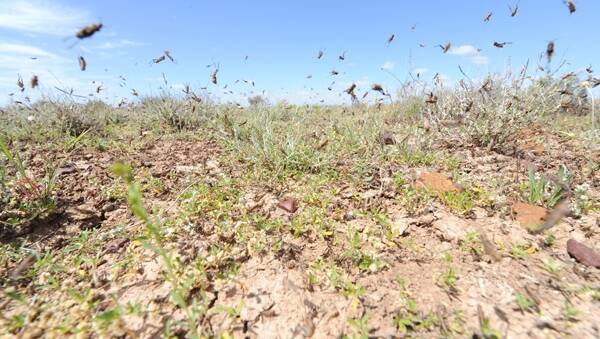
THE AUSTRALIAN Plague Locust Commission is keeping a close eye on locust numbers through the Riverina after recent monitoring.
Across Australia numbers are generally low, but Chris Adriaansen, head of the APLC, said in the commission's most recent surveys there had been high numbers of adults found in parts of the western Riverina around Jerilderie and Deniliquin up to Darlington Point.
Mr Adriaansen said that while numbers through NSW were probably lower than at this stage last year, the summer generation last year failed to develop meaning problems could still emerge in late summer and early autumn.
"We had solid spring numbers of locusts in late 2020 but then there was cool weather and the adults did not breed in great number so the population did not get out of control," Mr Adriaansen said.
"This year there has been good rainfall in early summer, followed by more rain in the last week or two so that means there will be a good source of food for the locust nymphs we have just seen starting to hatch recently," he said.
"So just because the numbers were lower earlier it does not mean it will stay that way."
The geography of the outbreak is also of concern, lying in the heart of a rich irrigated cropping region.
"Last year the worst numbers were probably a little further north and west and not so much in the irrigated cropping regions," Mr Adriaansen said.
He said the take-home message for farmers was the same as any time locust numbers are building to problematic levels.
"We're just urging everyone to get out and have a really good look, don't assume you don't have them."
In pleasing news, Mr Adriaansen said the locust population across the majority of the rest of eastern Australia was low.
"Surveys in Queensland identified occasional isolated - scattered-density adults in the Channel Country, Central West and Maranoa and Warrego districts, but overall the Riverina is the focus for potential concern at present," he said.
He said rainfall from here on would play a key role in any potential outbreak.
"The weak La Nina is likely to remain until early autumn, slightly increasing the chance of above average rainfall over much of eastern Australia, although January rainfall is less likely to exceed average," he said.
"Above average rainfall is forecast for February and March, with increased probability over the arid interior."
He said the ALPC was predicting a moderate increase in the overall population level, with medium to high densities persisting in the Riverina district and adjacent areas.
Low densities with limited localised medium to high densities are likely in other parts of inland eastern Australia.
It is likely that band development will start from early January onwards and swarm formation will begin in early February in the Riverina district and surrounding regions.
Under suitable weather conditions, some adults of the current spring generation may continue to migrate to adjacent districts and move further into adjacent interior areas.
Mr Adriaansen said there had been some reports of the spur throated locust, a primary tropical species of locust, in parts of Queensland.
Numbers were highest in the Channel Country, with some reports of the Maranoa and Warrego regions as well.
Monitoring was not done in Victoria and SA while the APLC does not cover WA.
Start the day with all the big news in agriculture! Sign up below to receive our daily Farmonline newsletter.


